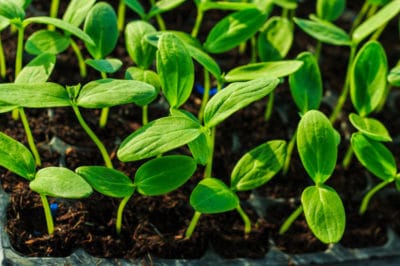Sprouting Conditions
In order to sprout, every cuke seed needs oxygen, water and the right soil temperature.
Oxygen
Cucumber sprouts’ tiny roots uptake oxygen from the air pockets in loose, well-draining soil. If your soil needs loosening, work a 2-inch layer of organic compost into it before planting. For indoor-started seeds, use a soilless seed-starter mix containing:
- Sphagnum peat moss for lightweight root support
- Organic compost, preferably with worm castings for nutrition.
- Perlite or vermiculite to for aeration and moisture retention
- Greensand for trace minerals
These ingredients are available at most home and garden stores.
Water
Mature cucumber seeds are much harder and drier than the immature ones from cucumbers harvested for the table. That’s because mature seeds have almost no moisture. Water swells and softens their shells so the embryonic sprouts’ tiny roots can break through.
The Right Temperature
To sprout, cucumber seeds need a soil temperature of at least 65°F (18.3°C). The warmer the soil is, the more quickly the sprouts will appear. Expect to wait more than 10 days if the soil is between 65° and 80°F (26.6°C), and between three and 10 days if it’s between 80° and 90°F (32.2°C).
Expert gardener’s tip: A cuke seed packet’s “time to harvest” number refers to the number of days it takes a vine to get from the sprouting to the picking stage.
Ongoing Care
To grow into healthy, vigorous seedlings, cuke sprouts need:
Sunlight
Cuke sprouts get their first nourishment from a pair of specialized leaves called cotyledons. After a few days, they get true leaves and begin photosynthesizing food. For that, they need at least six hours of sunlight each day.
Humidity
Cuke sprouts “breathe” through tiny openings, or stomata, in their leaves. If the air’s too humid, their stomata stay closed and their roots don’t absorb nutrients and water. To ensure that indoor sprouts’ humidity stays low, their stomata stay open and their nutrients keep flowing, place an oscillating fan set on low or medium nearby.
Watering
Water the sprouts enough to keep their soil or growing medium evenly moist — never saturated. To test the moisture level, insert a finger into the soil. If it feels dry beyond your first knuckle, water.
